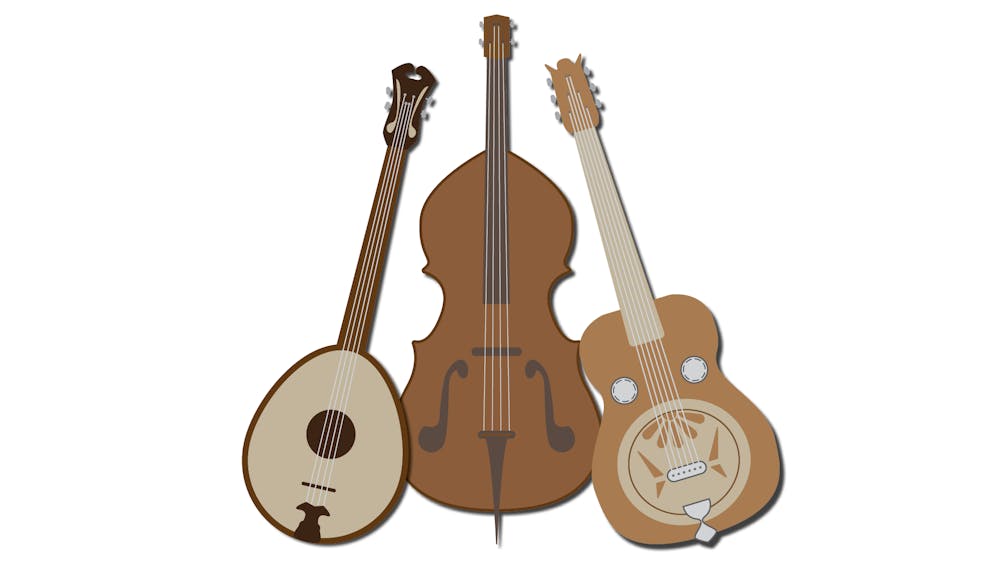Elon sophomore Ryan Sease, one of the Merlefest attendees, grew up listening to bluegrass music with his father and fell back in love with it listening to Molly Tuttle’s cover of “Olympia, WA,” by Rancid. Since then, he’s listened to her music constantly.
“I once saw her live and that was with Bryan Sutton and a bunch of other people, and then I was obsessed with it,” Sease said. “From that point onwards, it was, like, the main thing I listened to.”
Over the course of the past year, bluegrass music has grown popular among the Elon community, especially among students like Sease, an age demographic not usually connected to the genre.
According to the Library of Congress, bluegrass music is a “tradition-based modern style of string band music.” Instruments frequently used in these four-to-seven person bands include the mandolin, fiddle, acoustic guitar, banjo and steel guitar. Bluegrass music contains elements of country music and folk music, while standing as its own genre through improvisation during live performances, a quality that Strings maintains.
North Carolina has an extensive history with bluegrass music, serving as the birthplace of Watson among many other bluegrass artists such as Sutton and the late Tony Rice. Sutton has 39,330 monthly listeners on Spotify while Rice has 145,777, although both artists have songs with millions of streams.
The Wide Open Bluegrass Festival is also hosted annually in Raleigh, which has brought more people to the genre, according to Americana artist David Dyer, who is based in the city. Dyer was supposed to serve as the first performance at the town of Elon social district but had to cancel due to a work trip.
Dyer also mainly attributes the rise in popularity of the bluegrass and Americana genre to the technological development of streaming.
“I think the best music now is coming out of that genre,” Dyer said. “So people are starting to discover that now because they can access it.”
Although Sease agrees with Dyer, he primarily listened to bluegrass through the radio before discovering Tuttle. He said his go-to station is WNCW, which is based in Wilkesboro, and just barely reaches his hometown of Greenville, South Carolina.
Bluegrass music originated in the 1600’s in the Appalachian Mountains of the United States — North and South Carolina, Tennessee, Kentucky, Virginia and West Virginia — with songs usually detailing daily life in the barren region of rolling hills and farms. It wasn’t until the invention of the phonograph and radio in the early to mid 1900’s that bluegrass music spread across the country, according to the Bluegrass Heritage Foundation.
Psychedelic bluegrass artist Billy Strings illuminated Winston-Salem with his recent two-night tour stop that attracted North Carolinians from all over the state, including members of the Elon University community. One of these nights was a tribute concert to the late Doc Watson, a traditional bluegrass artist many call an icon, for his 100th birthday.
Merlefest, an annual bluegrass and Americana festival founded by Watson in 1988, is held in Wilkesboro on the campus of Wilkes Community College. This year’s event featured artists like The Avett Brothers and AJ Lee and Blue Summit. Several Elon students attended the event, despite the torrential downpour at times.
Strings and Tuttle are some of Sease’s favorite artists, along with mandolin player Sierra Hull. He said that they are growing in popularity because of how young they are and how they can connect to young people in a time where popular music has become “impersonal and so inorganic.”
“No one's in this because they want to make money, they're doing it because they love it,” Sease said. “Everyone in it is at the top of their game because you can't play bluegrass and be bad because everyone's doing rhythm, everyone's doing solos, everyone is passionate for it.”
Sease said bluegrass has always had spikes of popularity throughout the 20th and 21st centuries, whether it was the soundtrack to the 2000 film “O Brother Where Art Thou?” or country artist Darius Rucker’s cover of “Wagon Wheel” by Old Crow Medicine Show. But in the 2020’s, Sease said Strings is the “new gateway to bluegrass.”
“There’s a whole generation of kids who grew up whose dads are Dead Heads, and I think that’s what’s getting people into that sort of thing because he’s a lot like the Grateful Dead,” Sease said. “People archive his shows every time he plays. People follow him around, I remember at his concert, I heard people say, ‘Oh, we’ve seen him 16 times.’ I was like, ‘That’s insane, I ain’t seen anything 16 times.’”
Julie Brown, the bassist for Randolph County-based bluegrass band, Hindsight Bluegrass, is also a fan of Strings. Brown does a two-hour radio show once a week where she frequently plays his music, and she said people love him because he does everything bluegrass.
“He's not doing just new stuff — not just his stuff — but he's going back and doing the old original bluegrass,” Brown said. “And so, it's not just giving people a new twist on bluegrass, it's giving people the original.”
Brown also said because Strings is so progressive in his own music, he’s able to attract young people to the genre because it’s “more in line with what they already like.”
Despite Strings blowing up in the bluegrass community, Sease urges anyone else who wants to get into the genre to not just focus on the newer acts, but to dive deeper.
“There's a whole 70 years of stuff built upon it. Go back and listen to whatever artists you like say inspired them because that's some premium stuff,” Sease said. “If it's good for them, it's good enough for you.”


